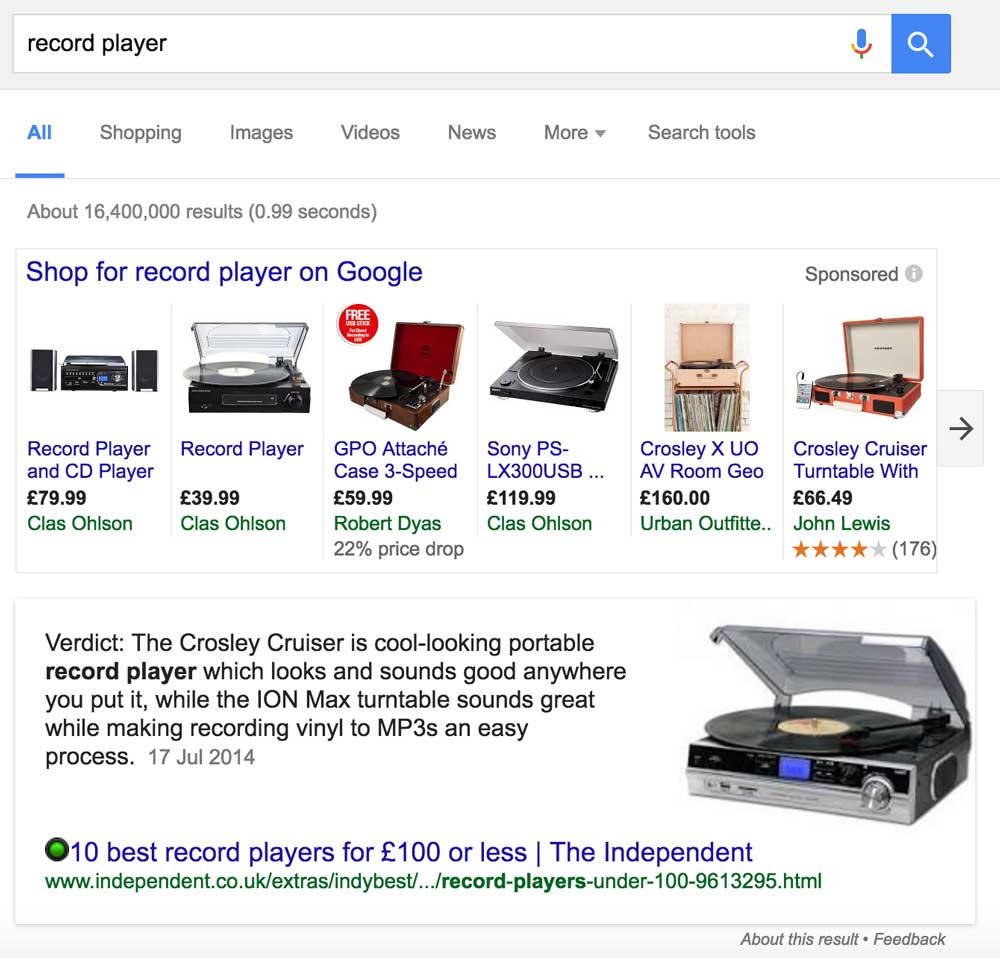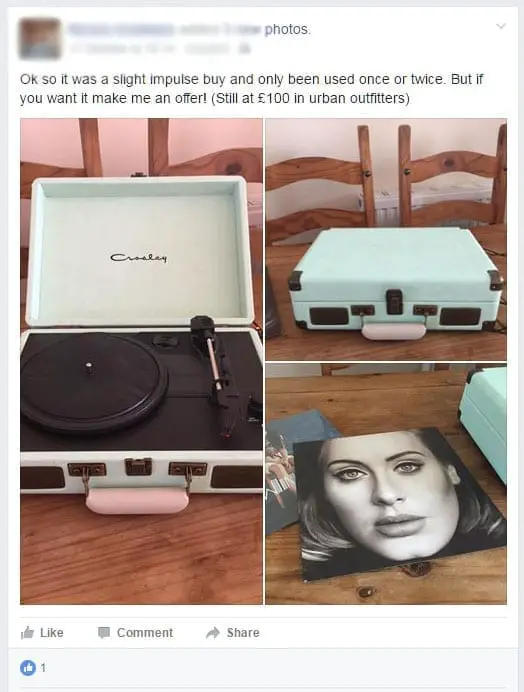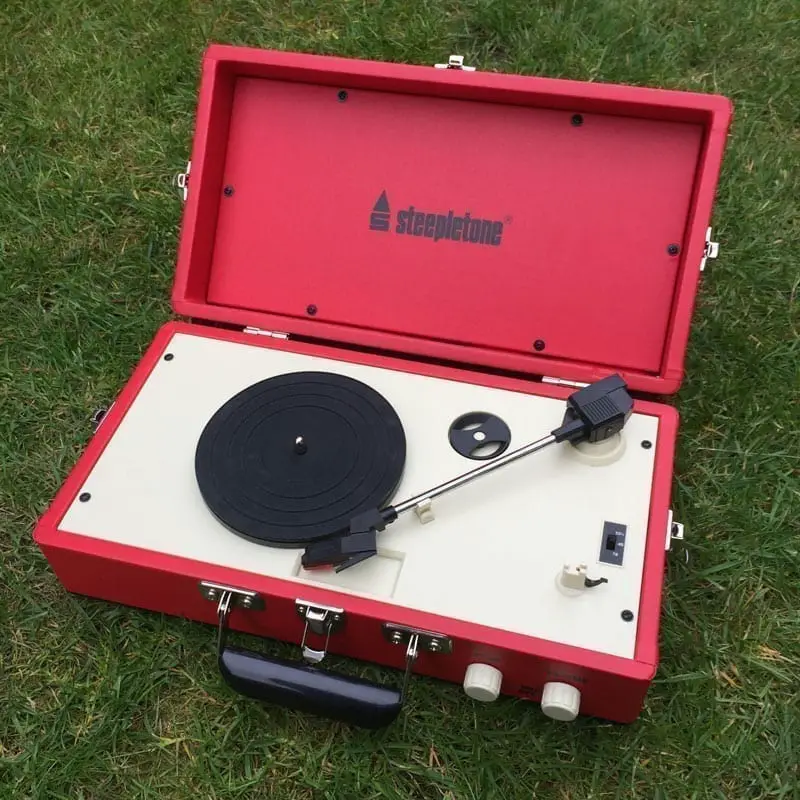As record sales continue to grow year-on-year, so too has the market for cheap starter record players. The demand is so great, last year’s hottest Christmas seller on Amazon was the Jensen JTA-230 3-speed stereo turntable with built-in speakers. Priced at just $51.99, it’s safe to say the majority of these players were bought as starter turntables.
The Jensen JTA isn’t the only cheap option, as a simple Google search reveals. The market is flooded with dozens of cheap, starter record players from the likes of Crosley and Steepletone. These cheaper record players are typically retro-styled in a throw-back to the old suitcase players of the 1960’s. Cute fashion accessory maybe, but serious hi-fi kit, they’re not.

What’s wrong with a cheap record player?
“What’s the problem?” I hear you ask. “They’re a starter piece of kit; they play records – what’s wrong with that!?”
Don’t get me wrong, they certainly have a place, there’s demand out there, and they’re serving a portion of the market. In fact, I even own a Steepletone for playing cheap and damaged records – it looks cool and creates a nice lo-fi atmosphere at dinner. If a fashion accessory is all you’re looking for great, I wish you luck. But if you’re hoping to start a vinyl collection for serious music enjoyment, I’m afraid I can’t recommend these turntables.
the dollar bin… if you own a crosley or equivalent turntable, never pay more for a record. #blono #records #thedollarbin #ilstu #IWU pic.twitter.com/uUnlSfyEtY
— Reverberation Vinyl (@reverberationbn) October 25, 2016
The Crosley Cruiser is arguably the best known cheap record player on the market, helped in part by their partnership with Urban Outfitters whereby Crosley provides exclusive turntables that change in style from season-to-season. In the UK, their popularity was fuelled further when Sainsbury’s supermarket started stocking Crosley record players in March this year. As the best-known player in this market, I’m going to use the Crosley Cruiser record player as an example of why you shouldn’t buy a cheap record player to start a serious vinyl collecting hobby.
Tracking Force
Tracking force is the downward pressure your stylus (needle) places on the record surface. The typical tracking force will vary from manufacturer to manufacturer, but most agree the safe area is between 1.5 and 2.5 grams. Track too light, and the sound becomes thin and edgy; track too heavy, and your music will sound dull and lifeless.
Incorrect tracking force will also have an adverse effect on the longevity of your records. Both light and heavy tracking prevent the stylus from accurately tracing the record grooves, which means the diamond stylus will mis-track, causing increased record wear.
A Crosley Cruiser tracks at an eye-popping 7 grams! At such a heavy weight, excessive record wear over time is inevitable. Unfortunately, the tonearm does not allow for weight adjustment.
Cheap tonearm
Cheap record players cut a lot of corners when it comes to tonearm design. Namely, the cartridge is pre-fit and none-adjustable, meaning you cannot change or align your cartridge. Couple this with a very short tone arm and we’re likely to have a situation where alignment is poor, and there’s nothing you can do about it.
Why is alignment important?
When your stylus tracks the grooves of a record, it’s important to maintain a steady position aligned neatly in the center of the groove as much as possible. If your cartridge alignment is off, the stylus will not accurately track the groove, and this will affect sound quality and record wear. The effects of poor cartridge and tonearm alignment are most noticeable at the grooves closest to the end of each side on a record. (Check out our previous post on inner-groove distortion and cartridge alignment for more on this topic).
It’s simple really – higher quality tonearms give you greater control, better build quality, and ultimately, better sounding records.
No adjustment options
Further to the lack of adjustment mentioned so far (no counter-weight and no cartridge alignment), the Crosley Cruiser (and other similar record players) do not allow many other crucial adjustments. There’s no anti-skate (a small weight that counter-acts the records natural pull toward the center spindle). There’s also no tonearm height adjustment (a critical piece in the cartridge alignment mix).
When playing a record, you’re literally dragging a microscopic diamond stylus tip (the hardest known material) through grooves cut into a polyvinyl chloride disc that are less than a human hair wide. Any misalignment through cheap components will easily cause damage.
Poor Sound Quality
The result of the above omissions is a tinny and shrill sound, with very little resolution and depth. This outcome is, of course, not helped by the small, cheap built in speakers, which fail to deliver – even when playing music from an iPod (one of the other applications you can use a Crosley, Steepletone, and many other similar players for).
Let’s be fair…
Crosley, Steepletone, and the likes, clearly aren’t going after the premium turntable market. A partnership with Urban Outfitters basically tells the consumer they’re buying a fashion accessory, but that doesn’t stop some people in the industry worrying about the impact of cheap turntables on the vinyl revival, as one anonymous audiophile stated in this article from the Guardian:
“The Crosley boom and subsequent disappointment with the product could harm the vinyl revival.”
…and you know what, they could be right; the screenshot below would certainly seem to suggest buyers remorse could well be a regular occurrence. How much of this is down to the product deterring consumers from exploring vinyl further is up for debate.

When all is said and done, you get what you pay for. If you’re happy to buy a fashion accessory for a bit of novelty value, then a Crosley or similar could be right up your alley. If however, you’re looking to start a real record collection (even just a casual one), I’d suggest investing a little more cash to save yourself a potential headache. Collecting vinyl records is a rewarding, if a little fussy, hobby. You don’t need to spend a fortune to get excellent results; you just need to invest to a basic quality standard.
To learn what you need to get started with vinyl today, check out our previous article detailing recommended components to get up and running with great sound on a budget.




[…] Crosley Record players get a bad rap among serious collectors, and for a good reason. But the fact remains, for some consumers, they serve a purpose. If all you want is the ability to play back a record for nostalgic vibes and you can’t see yourself progressing beyond this point, then fine—but if you’re looking for the great sound of vinyl you’ve heard so much about, prepare to be disappointed. […]
[…] turned out to be a big mistake. If you’re at all tempted to go cheap, think again, as a cheap turntable can be a real headache when it comes to skipping, not to mention the added wear on your records and disappointing sound. […]
I found this interesting. I bought an old sanyo tpx1 that was faulty for about £15, and fixed it with a new cartridge, lots of youtube watching and a printable protractor. The new cartridge was only £10 from China, but it’s only temporary until I can get a Grado. Maybe it’s because I’m a guy and we love fixing things, but it made more sense to me than paying £100 for a substandard turntable plus I get to learn about the inner workings. I wonder why more people don’t fix up old turntables like they do cars?
[…] was recently reminded of the cheap turntable predicament when a friend asked for my opinion on a Black Friday deal they’d spotted. I attempted to […]